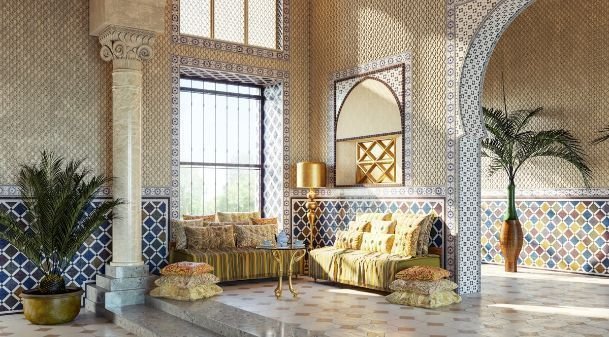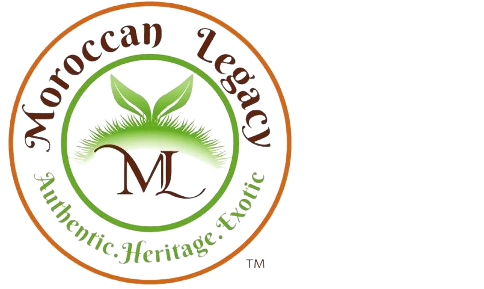Introduction
Morocco is a North African country located between the Atlantic Ocean and the Mediterranean Sea, with a long history that has shaped its unique culture and traditions. One distinct aspect is Moroccan art and design’s vibrant colors and distinctive patterns. From the mad, colorful tiles adorning iconic buildings like mosques and medinas to the creative handcrafted items like carpets, pottery, and textiles – Moroccan aesthetics are full of delightful colors that offer joy, harmony, and inspiration.
Growing up in a small town in Northern California, I was always fascinated by different cultures and traditions worldwide. As an art lover and passionate about interior design, I was especially drawn to styles that used bright, vivid colors in creative ways. When I first visited Morocco a few years ago, I was stunned by the magnificent displays of color everywhere I looked. From that trip onwards, I became very interested in learning more about Moroccan art forms and why colors play a pivotal role.
In this blog post, I hope to share what I’ve learned about the significance of color in Moroccan design through the centuries and spotlight a few iconic art forms that best represent this vibrant aesthetic. My goal is to provide insights that give readers a deeper appreciation for Moroccan culture and inspire them to incorporate these beautiful hues into their own spaces. I’ve tried to research from credible sources and present the information in an engaging yet respectful manner. Please feel free to let me know if you have any other questions!
The Origins of Color in Morocco
To understand the prominence of color in Moroccan art, looking at some of the historical and religious influences that have shaped design traditions over time is helpful. Morocco’s earliest inhabitants include the Berbers, Phoenicians, and Romans, who introduced techniques like tile-making, which later flourished under Moorish rule. However, Islam’s arrival in the 7th century CE had one of the most significant impacts on Moroccan aesthetics.
Islamic principles encourage ornate decoration to showcase craftsmanship and praise God through beauty. At the same time, certain hadiths (traditions of Prophet Muhammad) cautioned against vivid colors that might promote vanity or distraction from worship. As a result, decorative elements took on symbolic meanings, and colors were saturated without appearing too flashy. Furthermore, Islamic geometric and plant-inspired motifs inspired non-figural artwork compatible with religious teachings.
This cultural fusion of Berber, Arab, and Andalusian influences led to the distinctive Moroccan style over the centuries. Another theory for the significance of color relates to Morocco’s location along trading routes – it had easy access to rare pigments from sub-Saharan Africa and the Middle East. For example, the coveted indigo plant only grew in certain parts of Morocco, making the blue hue highly valued. Overall, religion, trade, and cultural exchange all played a role in uplifting color as a core part of Morocco’s visual heritage.
The Art of Zellige Tiles
One feature that immediately comes to mind when thinking of iconic Moroccan design is the lavish use of colorful zellige tiles. These glazed ceramic squares have been adorning buildings for over 800 years, from tiny homes to royal palaces and prestigious mosques. Zellige comes from an Arabic word meaning “small polished stone,” although today, the term refers to meticulously cut and arranged tiles.
Traditional Moroccan tiles are made by painting special clays onto molds and then firing them at high temperatures to produce a durable protective surface. Popular zellige patterns showcase geometric, floral, and calligraphic shapes arranged repetitive yet harmoniously. They are composed of small units that come together as a cohesive mosaic, allowing large surfaces to be covered efficiently with abundant ornamentation.
The versatility and beauty of zellige meant it became central to Moroccan architecture over the centuries. It waterproofs walls while creating delightful visual textures in striking blue, green, yellow, and other vivid hues. Some of the most renowned applications include:
- The Hassan II Mosque in Casablanca – At over 560,000 sqft, it holds the record for the most extensive handcrafted zellige tile panel ever constructed. Over 9.3 million tiles were used in a kaleidoscope of patterns.
- The Alhambra Palace in Granada, Spain – Built under Moorish rule, these ornate rooms demonstrate how zellige paved the way for North Africa’s notable influence on Andalusian design.
- Medina of Fez – Winding alleys are lined with exquisite traditional homes, riads, and madrasas featuring elaborate tile mosaics on all exterior surfaces.
- Batha Museum in Meknes – This restored late 18th-century mansion retains some of the finest tilework using rare pigments like cobalt blue.
The beauty and craftsmanship of zellige tilework have kept this Moroccan art form alive for centuries. It remains a source of excellent pride today and a key element defining Moroccan architecture’s distinctiveness globally.
Berber Textiles – Vibrant Carpets and Rugs
Another highly renowned Moroccan craft that shows the region’s appreciation for bright colors is handwoven textiles, especially carpets and rugs created by Berber artisans. Berbers are the indigenous inhabitants of North Africa with their language and cultural practices, and textile work has long been an integral part of their heritage. Traditionally, rugs held religious and practical functions in Berber homes besides being decorative, as they were used for prayer and insulation from cold stone floors.
Some key characteristics of Berber weavings include their various textures, from flat, knotted piles to more complex woven designs. Distinctive patterns stem from Berber tribal emblems like stars, squares, and flowers. Different colors like turquoise, pink, yellow, and crimson are blended in stripes, blocks, or abstract styles. Wool from sheep, goats, and camel hair is commonly hand-spun and then tightly knotted up to 200,000 knots per square meter on hand-made looms. Finished Berber rugs and carpets vary in size and can take months to years to complete.
Production remains rooted in Berber villages where weaving skills have passed through generations, relying on nature for supplies and traditional techniques. Three main types are:
- High Atlas Rugs from the Atlas mountain region feature complex geometric motifs woven with vibrant reds, greens, and blues.
- Souss Valley Carpets are Hallmarked by tribal motif strips separated by plain ones woven from different colored wools.
- Tazenakht Rugs are Made using only reds, maroons, or mustard yellow and are known for their graphic linear designs.
While Moroccan rugs hold monetary value due to their uniqueness and craftsmanship, Berbers retain a more profound cultural and symbolic significance relating to their history and identity. This living folk art continues to be a vital revenue source for artisans and represents the richness of Berber cultural heritage.

Pottery Traditions from Fez and Safi
Ceramic handicrafts making vibrant use of shiny glazes have also flourished for centuries in Morocco. Two noteworthy origins are the cities of Fez and Safi, both renowned centers of pottery tradition with styles influenced by ancient Mediterranean, Middle Eastern, and local Berber designs. Artisans skillfully mold, throw, carve, and paint functional and decorative objects to beautify homes.
In Fez, one type dating back 1200 years is Sapienza or Hispano-Moresque ware, using tin-glazed earthenware coated in a shiny transparent glaze tinted blue, green, or yellow. Distinctive patterns incorporate floral forms, Arabic calligraphy, or simple geometric outlines. Another Fez specialty is hand-painted and incised terracotta pottery, typically decorated in rich earth tones.
Safi on the Atlantic coast developed its lusterware style that became famed across North Africa and Spain. Metallic salts were applied to matte glazes fired at high temperatures, creating iridescent effects resembling mother-of-pearl. Delicate flowers, leaves, and other plant-inspired motifs adorn teapots, serving platters, and vases emanating a jewel-tone shimmer.
Fez and Safi ceramic traditions relied on local clays and minerals, with Safi specifically valuing copper compounds yielding sea green and amethyst hues in its pottery glazes. Their works of functional pottery alongside ornamental items represented different economic classes yet similarly showcased pride in craftsmanship through vibrant color schemes. Though production has modernized, these Moroccan cities continue honoring ancestral pottery legacies.
The Joyful Expressions of Naive Art
Moving past the formalized handicrafts of Moroccan cities, folk art traditions arose in rural areas, expressing local perspectives through vibrant self-taught styles. One branch is Moroccan “naive art” generated by village painters using bold hues without academic training. Subjects often portray daily pastoral or cultural scenes interpreted through a joyful lens with flat, colorful patterns.
- Symbolism of colors: Different hues have symbolic meanings in Islamic cultures. Blue represents the heavens, green is the color of nature/fertility, and red symbolizes passion or sacrifice. These associations magnify the arts’ spiritual dimension.

